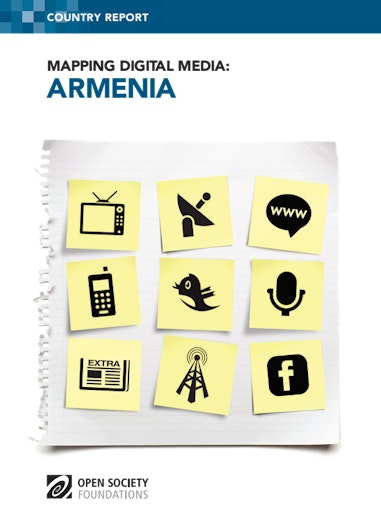The Mapping Digital Media project examines the global opportunities and risks created by the transition from traditional to digital media. Covering 60 countries, the project examines how these changes affect the core democratic service that any media system should provide: news about political, economic, and social affairs.
Recent years have seen a rapid expansion of the internet in Armenia, not only among the residents of the capital city and other urban areas, but also in remote regions of the country. It was particularly noticeable in 2010–2011, when the number of internet users increased by almost 40 percent.
The report finds that, overall, digitization has increased the diversity of media outlets and their news offer, and the plurality of opinions expressed. Yet the lack of independence of regulatory institutions, non-transparent media ownership, flawed broadcast legislation, and the slow pace of digital switch-over continue to obstruct the development of the media sector. Television, the main source of information, is still largely controlled by the authorities. There is widespread hidden censorship as a result of political pressure on media outlets, which especially affects the news and political output on television. Most media outlets remain dependent upon large businesses and the political elite, with which they have become integrated.
Download
-
Mapping Digital Media: Armenia (1.09 Mb pdf file)
Download the complete 104-page report.
-
ՀԱՅԱՍՏԱՆ ՄԵԴԻԱՆԵՐԻ ԹՎԱՅՆԱՑՄԱՆ ՔԱՐՏԵԶԱԳՐ (667.37 Kb pdf file)
Download the complete 137-page report in Armenian.
-
Карта Цифровых CМИ: Армения (623.96 Kb pdf file)
Download the complete 114-page report in Russian.
Read more
Voices
What Does Independent Journalism Look Like in the Digital Age?

Journalists and media organizations can find themselves repressed because of inadequate or deliberately repressive policy. Mapping Digital Media examines the situation in 56 countries.
Voices
Does Digital Media Mean Better Media?
From Montenegro to Nicaragua to China to Egypt, has digital media improved access to good-quality journalism?
Voices
Early Days for Digital Media in Morocco
Digital media in Morocco continues to advance. With 105 percent mobile phone penetration in the country and a growing appetite for online news more change is on the way.
